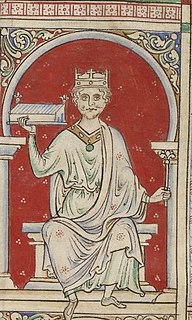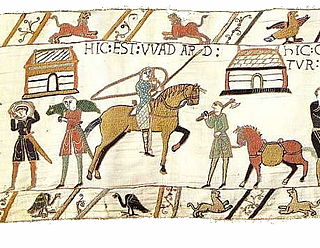Related Research Articles

Year 1088 (MLXXXVIII) was a leap year starting on Saturday of the Julian calendar.

The Bayeux Tapestry is an embroidered cloth nearly 70 metres (230 ft) long and 50 centimetres (20 in) tall that depicts the events leading up to the Norman conquest of England concerning William, Duke of Normandy, and Harold, Earl of Wessex, later King of England, and culminating in the Battle of Hastings. It is thought to date to the 11th century, within a few years after the battle. It tells the story from the point of view of the conquering Normans but is now agreed to have been made in England.

Odo of Bayeux, Earl of Kent and Bishop of Bayeux, was the maternal half-brother of William the Conqueror, and was, for a time, second in power after the King of England.

The title of Duke of Kent has been created several times in the peerages of Great Britain and the United Kingdom, most recently as a royal dukedom for the fourth son of King George V. Since 1942, the title has been held by Prince Edward, Queen Elizabeth II's cousin.

Bayeux is a commune in the Calvados department in Normandy in northwestern France.
The peerage title Earl of Kent has been created eight times in the Peerage of England and once in the Peerage of the United Kingdom.

The Rebellion of 1088 occurred after the death of William the Conqueror and concerned the division of lands in the Kingdom of England and the Duchy of Normandy between his two sons William Rufus and Robert Curthose. Hostilities lasted from 3 to 6 months starting around Easter of 1088.

Thomas of Bayeux was Archbishop of York from 1070 until 1100. He was educated at Liège and became a royal chaplain to Duke William of Normandy, who later became King William I of England. After the Norman Conquest, the king nominated Thomas to succeed Ealdred as Archbishop of York. After Thomas' election, Lanfranc, Archbishop of Canterbury, demanded an oath from Thomas to obey him and any future Archbishops of Canterbury; this was part of Lanfranc's claim that Canterbury was the primary bishopric, and its holder the head of the English Church. Thomas countered that York had never made such an oath. As a result, Lanfranc refused to consecrate him. The King eventually persuaded Thomas to submit, but Thomas and Lanfranc continued to clash over ecclesiastical issues, including the primacy of Canterbury, which dioceses belonged to the province of York, and the question of how York's obedience to Canterbury would be expressed.

Luddenham is a widespread hamlet or small village north-west of Faversham in Kent, England, with many long-distance views across the Swale and the Isle of Sheppey. It is on the edge of Luddenham Marshes and is also home of Luddenham School. Oare Gunpowder Works are on the edge of the village. It had, according to Edward Hasted in 1798, 396 acres of low flat arable land and 200 acres of meadow and pasture, although half of those are marsh. It is in the civil parish of Norton, Buckland and Stone.

Badlesmere is a village and civil parish in the Swale district of Kent, England, and about five miles south of Faversham.

William the Conqueror had men of diverse standing and origins under his command at the Battle of Hastings in 1066. With these and other men he went on in the five succeeding years to conduct the Harrying of the North and complete the Norman conquest of England.

Tunstall is a linear village and civil parish in Swale in Kent, England. It is about 2 km to the south-west of the centre of Sittingbourne, on a road towards Bredgar.

Coldred is a settlement in the Shepherdswell with Coldred civil parish in the Dover District of Kent, England. The main part of the village is Coldred Street which lies 1⁄2 mile (0.80 km) to the south-west.

Tonge is a village near Sittingbourne in Kent, England. The hamlet is north of Bapchild, close to Murston Marshes beside the Swale.

Penenden Heath is a suburb in the town of Maidstone in Kent, England. As the name suggests it is nucleated around a former heath.
The trial of Penenden Heath occurred in the decade after the Norman Conquest of England in 1066, probably in 1076, and involved a dispute between Odo, Bishop of Bayeux, half-brother of William the Conqueror and Lanfranc, Archbishop of Canterbury and others.
Events from the 1080s in England.

Wichling is a village and civil parish within the local government district of Maidstone, in England. The parish lies approximately 10 miles (16 km) to the east of Maidstone. It lies near the top of the ridge of the North Downs and consists mainly of isolated farms and houses: the population is therefore small in number.

Abbot Scotland v Hamo the Sherrif or more precisely versus Hamo the Steward, Sheriff of Kent as agent for Bishop Odo of Bayeux, the Earl of Kent (1076) was a determination by William the Conqueror of an English land law suit.

Wadard was an 11th century Norman nobleman who is mentioned in Domesday Book, and is depicted in the Bayeux Tapestry.
References
- ↑ "The Domesday Book: England in 1085 genealogy project".
- ↑ Edward Hasted, 'The town and parish of Fordwich', in The History and Topographical Survey of the County of Kent: Volume 9 Pages 56-67.
- ↑ Hist Mon St Aug 352 (abbey of St Augustine, Canterbury).